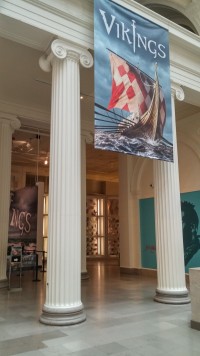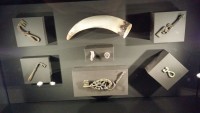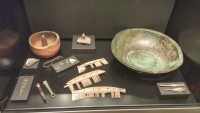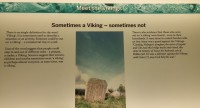
Entrance to Vikings Exhibit, Field Museum.
Last year, I had the opportunity to visit a Vikings exhibition at the Field Museum of Natural History in Chicago. I had been invited to Chicago to give a Skeptics in the Pub talk about the erroneous and distinctly odd belief that Leif Erickson discovered Bigfoot in Vinland. I gave the talk on Saturday and went to the exhibit on Sunday. It was a whole Viking-themed weekend—the best kind of weekend. Bigfoot was noticeably absent from the exhibit (and, indeed, the Field Museum in general).
In the last year, I have moved from Wisconsin to New Jersey, and the Viking exhibit has moved from Chicago to New York. I’m tempted to visit it again. I enjoyed it the first time, although it made me a little sad because it reminded me that I was not able to visit the British Museum’s 2014 exhibit, Vikings: Life and Legends. The two exhibits take very different approaches to the Vikings. The British Museum emphasized warfare, stating in one of its press releases:
New interpretations place warfare and warrior identity at the centre of what it meant to be a Viking; cultural contact was often violent, and the transportation of looted goods and slaves reflects the role of Vikings as both raiders and traders.
This focus was actually somewhat unusual. For some time, the trend has been to point out that Scandinavians of the Viking Age were not all bloodthirsty barbarians. Comparatively few were Vikings proper—raiders and pillagers. Many real Vikings were only part-time Vikings: they raided during the summer, and then went back to their farms for the rest of the year. Some were temporary Vikings: they raided until they acquired enough loot and perhaps some land; then they settled down. The Norse were also merchants, traders, great explorers, expert ship-builders, fine artists and craftsmen, and phenomenal poets and storytellers.
The Vikings exhibit that opened at Discovery Times Square on February 5 focuses on this softer, gentler, non-raiding side of Viking-Age Scandinavia (though this is somewhat undercut by the use of a sword for the second I in “Vikings”). Press releases and news stories about the exhibit have tended to emphasize myth busting. The New York Times review of the exhibit is called “‘Vikings,’ Here to Set the Record Straight.” An article in British tabloid the Daily Mail is called “Vikings did NOT wear horned helmets: Fascinating new Times Square exhibition with 500 artifacts debunks myths surrounding the ancient raiders.

The Vikings drank out of horns; they didn’t wear them.
Great, we all love a good debunking. So what myths are getting debunked? Well, for starters, every article and press release I’ve seen has insisted that Vikings did not wear horned helmets, although the gift shop at the Field Museum was well supplied with plastic facsimiles. It is true (or, at least, probably true) that the Vikings did not wear horned helmets, although I suspect that won’t come as much of a shock to most people. Archaeologists have found some Viking-Age helmets: none has horns. No contemporary depictions or descriptions of Vikings feature horned helmets. Although horned helmets and depictions of horned helmets have been found in Europe—some were found in Scandinavia, and some depict Germanic warriors—these are all prehistoric or from the Migration Period.
Artist Carl Emil Doepler is usually blamed for the Vikings’ fanciful headgear. He designed the costumes for Richard Wagner’s four-opera cycle Der Ring des Nibelungen at the Bayreuthe Festspiele in 1876. Wotan (Odin) and the Valkyries wore winged helmets. Hunding, one of the villains, sported a horned helmet. The winged helmets are also very much in evidence in Doepler’s illustrations for Nordisch-Germanische Götter and Helden (Nordic and Germanic gods and heroes). Of course, Wagner’s Ring Cycle doesn’t have anything to do with Vikings. Yes, the Germanic gods take an active and very loud role, and, yes, Wagner used Norse sources (as well as the Middle High German poem, the Nibelungenlied), but the action takes place in Germany (and Asgard/Valhalla, obviously) in the fifth and sixth centuries—the Migration Period.
What other myths does the exhibit debunk? Well, there’s the word “Viking” itself. According to the review in the New York Times:
“The word ‘viking’ was something that you did, it wasn’t something that you were,” Sophie Nyman, director of exhibitions, marketing and visitor services for the Swedish History Museum [one of the organizers of the exhibit], explained during a pre-opening tour. In the original meaning, one went “on a viking” — a journey for trading, raiding or settlement. Only in the 19th century did the word come to mean the people themselves.
This claim is echoed in a press release on PRweb:
Another myth is that the Vikings called themselves “Vikings.” Generally, the people of early Scandinavia named themselves after the farm, village, or region in which they lived. The word “Viking,” derives from Old Norse, and meant going on a trade or a raid. During the Viking era, people were not always out on these expeditions; most lived as farmers, merchants, and craftsmen.
The Field Museum takes a more moderate, if tautological, approach. Under the heading “Who they were,” they answer “FARMERS” and add:
The majority of people who lived across Scandinavia during the Viking Age were not warriors or mercenaries. Instead, most lived as farmers. They did not even call themselves Vikings unless they were out on “a viking,” an Old Norse word for a commercial trip or raid.
So they didn’t call themselves “Vikings” unless they were acting like Vikings. You can’t argue with that.
Did they or did they not call themselves or their contemporaries “Vikings”? To find out, I’m afraid we’re going to have to look at a dictionary, specifically Cleasby-Vigfusson, or, more formally, An Icelandic-English Dictionary (1874), based on the manuscript collections of Richard Cleasby and completed by Guðbrandur Vigfússon. We want page 716. First we see víking which is defined as “a freebooting voyage, piracy.” The authors add, “In heathen days it was usual for young men of distinction, before settling down, to make a warlike expedition to foreign parts, this voyage was called ‘víking,’ and was part of a man’s education like the grand tour in modern times.” There follows a substantial collection of quotes from medieval sources in which men are described as going “í víking” or “í vestr-víking” (going a-viking in the west). This is in accord with the claims made by people involved with the exhibit.
But, wait, there’s more. The entry also says “see víkingr,” and, indeed, immediately following víkingligr, an adjective meaning “like a viking, martial,” we find víkingr:
a freebooter, rover, pirate, but in Icel. Sagas used specially of the bands of Scandinavian warriors, who during the 9th and 10th centuries harried the British Isles and Normandy.

Combs, tweezers, ear scoops, and other grooming tools. The Vikings wanted to look nice while pillaging.
Oh dear. That certainly sounds as if Scandinavians used the word “Viking” to describe themselves and others long before the 19th century. And, sure enough, we are treated to an extensive collection of quotations (described as “a few selected references”) in which people are called “Vikings.” Some of these follow the pattern “X hét maðr, hann var víkingr mikill” (there was a man named X; he was a great Viking). There are also quotes from “old poems,” which, though written down after the Viking Age, may have been composed and transmitted orally much earlier. The authors also note that “in after times the word fell into discredit, and is used, esp. in eccl[esiastical] legends, as = robber, being applied by a misnomer even to highwaymen.” Indeed, both “vikingr” and “bersercr” (berserker) are used in this way in a didactic prose debate between the body and soul of a dead, soon-to-be-damned man included in the Old Norwegian Homily Book (c. 1200).
So Scandinavians did use the word “Viking” to refer to people, and by 1200 its use has expanded to include any sort of thief. Cleasby-Vigfusson also note that “the word is peculiarly Norse,” even though a cognate or borrowing appears in Old English. Anglo-Saxons started writing down their language centuries before the Scandinavians did, so we have examples of “wicing” from the Viking Age and possibly even earlier. The poem Widsið used to be regarded as one of the oldest Old English poems. Its dating has been questioned in recent years, but Leonard Neidorf argues that it was originally written down in the 7th century (the only extant manuscript copy is from the late 10th century). He also suggests that the basic content may be much earlier—before the Anglo-Saxons migrated to England. In the poem, the legendary scop (oral poet) Widsith lists legendary heroes from the Migration Period, including characters who appear in Beowulf and the Nibelung/Niflung/Volsung cycle. All the characters in the following passage appear in Beowulf (Hrothgar is the Danish king whose hall, Heorot, is being terrorized by the monster Grendel; Hrothulf is his nephew, and Ingeld is a Heathobard whose marriage to Hrothgar’s daughter fails to end war between the two tribes):
Hroþwulf and Hroðgar heoldon longest
sibbe ætsomne suhtorfædran,
siþþan hy forwræcon wicinga cynn
ond Ingeldes ord forbigdan,
forheowan æt Heorote Heaðobeardna þrym. (ll. 45-49)(Hrothulf and Hrothgar, uncle and nephew, held the peace together for a long time after they drove out the Viking-kin [race of Vikings] and humbled Ingeld’s vanguard, cut down the host of the Heathobards at Heorot.)
Later in the poem, Widsith lists a number of tribes he has encountered. Along with Danes, Geats (Beowulf’s tribe), Swedes, Angles, Saxons, and many more, Widsith was “mid wicingum” (with the Vikings, l. 59) and “mid Lidwicingum” (with ship-Vikings, l. 81). We don’t exactly know what the poet meant by “wicing,” since he twice uses the word as a tribe name, but, although the Lidwicingas are associated with sea-faring, they aren’t exactly Vikings in the sense we usually mean. For one thing, the poet is talking about a time before the Viking Age. If Neidorf is correct, the word itself could even predate the Viking Age. Regardless, it was certainly used to refer to people and not just an activity.
Another Old English poem that mentions wicingas is more clear cut. The Battle of Maldon is a late Old English poem that commemorates a historical event that occurred in August 991 CE. Ealdorman Byrhtnoth of Essex and his men fought valiantly but lost disastrously to a group of invading Vikings. After the battle, King Aethelred paid off the Vikings to make them go away. This was the first time the English paid the Vikings Danegeld. The poet uses the word wicing to refer to the Vikings repeatedly—six times to be precise. There’s no ambiguity here about what the poet means:
Wodon þa wælwulfas (for wætere ne murnon),
wicinga werod, west ofer Pantan
ofer scir wæter scyldas wegon,
lidmen to lande linde bæron. (ll. 96-99)(Then the slaughter-wolves, the troop of Vikings, waded west over the River Pante [Blackwater]–for they didn’t care about water–carried shields over the bright water, the seafaring men bore linden shields to land).
These men are invaders, marauders; they come from the sea and cheerfully wade through water. They are slaughter-wolves. In a word, they are Vikings. This is a poem almost certainly written during the Viking Age about a Viking invasion. It describes the Vikings as Vikings.
It’s true that most Scandinavians in the Viking Age were farmers. It’s also true that the victims of Viking raids are not entirely objective in describing the raiders. But it seems clear that “Viking” was used to refer to people during the Viking Age, not just to an activity.
Despite what the exhibit’s representatives have said about Vikings in publicity material, the existence of flesh-and-blood Vikings is grudgingly acknowledged in the exhibit itself. One sign mentions that people went “a-viking,” but also shows a photograph of a Swedish runestone (U 617). This is how the inscription is translated on the sign:
Sign with photo of runestone U 617, which mentions Vikings
Ginlögg, Holmger’s daughter, the sister of Sygrög and Göt, had this bridge made and raised, this stone in memory of Assur, her husband, son of Håkon jarl. He was a defender against the Vikings with Geter (?), may God rest his soul.
This is a fairly generous interpretation, as the inscription calls Assur “vikinga vorðr,” which could mean “watch (or guardian) of the Vikings.” Whether Assur was fighting Vikings or was a Viking himself, Vikings were involved.
Thinking critically about the way history is presented and sometimes misrepresented is great. Debunking is great. But it’s a mistake to debunk something that isn’t actually bunk.
References
- The Battle of Maldon. Qtd. from A Guide to Old English. 6th ed. Ed. Bruce Mitchell and Fred C. Robinson. Oxford and Maldon, MA: Blackwell, 2001. 241-52.
- Leonard Neidorf. “The Dating of Widsið and the Study of Germanic Antiquity.” Neophiliologus 97 (2013): 165-83.
- Widsið. Qtd. from The Exeter Book. Anglo-Saxon Poetic Records 3. Ed. George Philip Krapp and Elliott van Kirk Dobbie. New York: Columbia UP; London: Routledge, 1936. 149-53.
- All photos are by Robert Blaskiewicz, taken at the Vikings Exhibit at the Field Museum in March 2015. Used with permission.
- All translations are mine unless otherwise noted.












My dad once told me that “viking” was a verb not a noun, as the act on going on raids was “viking.” But I have learned over the years to be very cautious about his “truth.” Even though his undergraduate degree is in linguistics (and his graduate degree is from the Command and General Staff College from a school in Ft. Leavenworth, KS — he was multi-lingual, so he spent a bit of his Army career listening to certain radio channels most would not be interested in nor able to access).
Though the adjective he mostly used before the word “Norwegian” was “damn.” Mostly towards my mother and my maternal grandfather. And once towards me when I told him I actually like lutefisk.
I wish that Viking exhibit would come here to Seattle (and if it did I may have missed it!). There is the Nordic Heritage Museum in a neighborhood where there is a distinct Scandinavian heritage. Puget Sound is very much like a fjord.
(Weird little bit from a presentation at our local history museum by researcher of Native American history — the tribes up in Canada, where there are lots of fjords, were great boat builders and would come down here to raid villages and capture slaves. They were also great artists, the totem poles were from them, not from the ones in our area. I found the similarities to Viking culture intriguing. Also, the first totem pole brought to our city was from some <a href="http://www.historylink.org/index.cfm?DisplayPage=output.cfm&file_id=2076"white guys who went up to Alaska and stole it!).
I have been to Denmark, and the Viking Ship Museum in Roskilde does show much of the use of boats were for trade, with illustrations on what Viking life was like. There was very little raiding. (note that town also has the church/cathedral with the tombs of almost every Danish monarch for over five hundred years. It is amazing to see the design aesthetic change over that time span).
Anyway, it is cool and interesting stuff. These guys got around. Though the reason they traveled to other places like England, Normandy, Iceland and the USA was because it is hard to farm when you run out land… especially in the era of large families. Which is pretty much the story of why my grandfather’s parents left Norway in the 1870s (to Eau Claire, WI — I believe you have been there). It was that or starve. Which our local Nordic Heritage Museum explains.
British Sovereigns struck in more recent years are in high demand amongst investors rather then collectors.
http://mandystam.nl
Fascinating, but I hardly think that any population of humans can be described by one adjective. What kind of historian would do or has done that?
My daughter brought back a Viking figure from the Stockholm Museum in Sweden.
Guess what? The helmet had horns on!
From what I have read, there seem to be two politically correct trends. One emphasizes the kindler, gentler, farming Viking discussed above. The other insists that the Vikings were the earliest Europeans to visit North America (centuries before Columbus). The latter was what we were all taught in school, but The Farfarers: A New History of North America, by Farley Mowat, makes an interesting case for much earlier westward explorations, linked to the valuable trade in walrus tusks.
Ah, I had a feeling my interpretation was too simplistic. I stand corrected and thank you for your reply :-)
Most of those suffixes are inflectional. In Old Norse, most strong masculine nouns have an -r suffix in the nominative singular. It’s sort of like the -us ending of masculine second declension nouns in Latin (eg. spiritus, amicus, etc.). Old English “Wicinga” is genitive plural; “wicingum” is dative plural. “Vikingligr” is a compound–“Viking-like”–but, again, the -r is a case marker indicating that the word is nominative, masculine, and singular. In this case the word is an adjective and so, consequently, has feminine and neuter forms as well, but the strong masculine form is what is used in dictionaries.
IANAL (I Am Not A Linguist), but, after reading this, I did NOT come to the conclusion that people were called “Vikings” at all. It seemed to me that every time the word was used to refer to a person or persons it had a suffix: víkingligr, vikingr, wicingum, wicinga, etc. To me this would indicate that the original statement, that ‘viking’ was an activity, still rings true. Examples:
I can go on an adventure, during which people would correctly refer to me as an adventurer.
I can go on a journey, be called a journeyman.
I can go on a raid and be called a raider. Et cetera.
Is this the same as saying people are referred to as ‘adventures’, ‘journeys’, and ‘raids’? Nope. You can’t just drop letters and suffixes from words and declare them to have the same meaning. You can’t call lawyers ‘laws’ and you can’t call looters ‘loot’. Right?
But, again, IANAL. And I haven’t had my coffee.